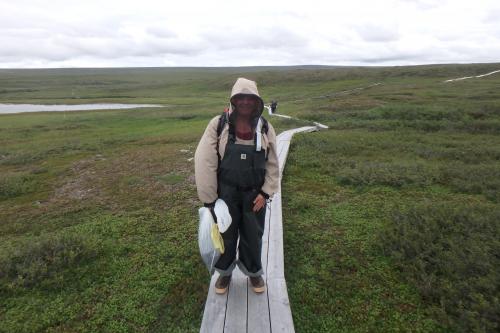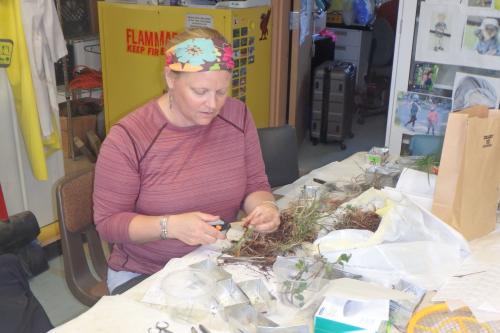It has been a busy week in the field! We have started the pluck. The pluck. Our team has been preparing for this but I really had no idea the complexity of the actual "pluck." The first step to the infamous pluck is to go to the field and take a quadrat of earth. This is done with a "butter" knife, according to Dr. Bret-Harte, but they are actually quite sharper than a butter knife. Once the metal quadrat is in place and oriented, what is in the quadrat and what is out of the quadrat is determined. Only plants within the quadrat limits are collected. Then the cutting begins. To be honest, it is intimidating. This project was started in 2006 and twelve years later the plants are being harvested. There can only be one cut. One. Just a little pressure...
 Svea Anderson in the field cutting the quadrat sample.
Svea Anderson in the field cutting the quadrat sample.
 Svea Anderson in the field with the cut quadrat. The earth is placed in white bags for transport back to the lab.
Svea Anderson in the field with the cut quadrat. The earth is placed in white bags for transport back to the lab.
The earth is then taken to a freezer for the night to help preserve the plants. In the morning, the bags are delivered to the lab where they are strategically placed in front of teams of people. Dr. Bret-Harte has a large crew of volunteers for this part of the project.
 The bag of earth in the lab ready for the pluck.
The bag of earth in the lab ready for the pluck.
 Once the plot has been sorted into species, it is further sorted into plant parts for biomass purposes.
Once the plot has been sorted into species, it is further sorted into plant parts for biomass purposes.
 Svea Anderson in the lab sorting plant species as part of the pluck.
Svea Anderson in the lab sorting plant species as part of the pluck.
The plots are first sorted by species. Then they are further sorted by parts. The parts are then collected in small cookie bags and put in an oven for a few days. Once the moisture has been eliminated from the samples, they will be further sorted and then weighed for biomass. The rest of the work on the pluck, the grinding and the data collection in the mass spectrometer will be completed in Fairbanks later this year.


Comments
Add new comment